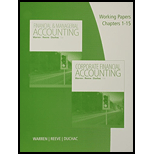
Deferrals:
Deferrals refer to the revenues that are collected in advance before the services are provided or sales are made to the customer, and the expenses are paid in advance before the expenses are incurred.
Deferrals are classified into two types. They are prepaid expenses, and unearned revenues.
Prepaid expenses: The expenses are paid in cash, before they are incurred.
Unearned revenue: The cash is received, before the services are performed.
Accruals:
Accruals refer to the revenues that are generated from goods delivered or, service performed to the customer, but cash is not yet received from the customer, and the expenses are incurred, but cash is not yet paid.
Accruals are classified into two types. They are accrued revenues, and accrued expenses.
Accrued revenues: Revenues are generated but not yet received in cash.
Accrued expenses: Expenses are incurred but not yet paid in cash.
To indicate: The types of adjustment for the given transactions.
Want to see the full answer?
Check out a sample textbook solution
Chapter 3 Solutions
Working Papers, Volume 1, Chapters 1-15 for Warren/Reeve/Duchac's Corporate Financial Accounting, 13th + Financial & Managerial Accounting, 13th
- How much should be recorded as goodwill??arrow_forwardNot use ai solution please and accounting questionarrow_forwardOn January 1, 2025, Fisher Company makes the two following acquisitions. 1. 2. Purchases land having a fair market value of $800,000 by issuing a 5-year, zero-interest-bearing promissory note in the face amount of $1,175,468. Purchases equipment by issuing a 4%, 8-year promissory note having a maturity value of $350,000 (Interest payable annually on January 1). The company has to pay 8% interest for funds from its bank. (a) (b) Record the two journal entries that should be recorded by Fisher Company for the two purchases on January 1, 2025. Record the interest at the end of the first year on both notes using the effective-interest method. (Round present value factor calculations to 5 decimal places, e.g. 1.25124 and the final answer to O decimal place, e.g. 58,971. If no entry is required, select "No Entry" for the account titles and enter O for the amounts. Credit account titles are automatically indented when the amount is entered. Do not indent manually. List all debit entries…arrow_forward
- Principles of Accounting Volume 1AccountingISBN:9781947172685Author:OpenStaxPublisher:OpenStax CollegeCentury 21 Accounting Multicolumn JournalAccountingISBN:9781337679503Author:GilbertsonPublisher:Cengage
 Cornerstones of Financial AccountingAccountingISBN:9781337690881Author:Jay Rich, Jeff JonesPublisher:Cengage Learning
Cornerstones of Financial AccountingAccountingISBN:9781337690881Author:Jay Rich, Jeff JonesPublisher:Cengage Learning Intermediate Accounting: Reporting And AnalysisAccountingISBN:9781337788281Author:James M. Wahlen, Jefferson P. Jones, Donald PagachPublisher:Cengage Learning
Intermediate Accounting: Reporting And AnalysisAccountingISBN:9781337788281Author:James M. Wahlen, Jefferson P. Jones, Donald PagachPublisher:Cengage Learning College Accounting, Chapters 1-27AccountingISBN:9781337794756Author:HEINTZ, James A.Publisher:Cengage Learning,
College Accounting, Chapters 1-27AccountingISBN:9781337794756Author:HEINTZ, James A.Publisher:Cengage Learning,





